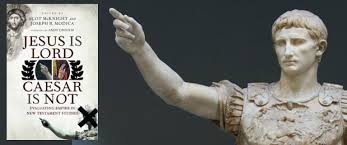The first two articles in this volume are of the nature of survey articles, which is a good thing for readers unfamiliar with the topic of ‘The NT and the Imperial Cult’. We will summarize a few of the major points made by David Nystrom and discuss them in this post and do the same for the second article by Judith Diehl in the next post. One of the nice features about this book is that the chapters do not go on forever (contrast Tom Wright’s recent tome) and the writing is clear and to the point.
As Nystrom points out, the Roman project from at least Augustus onwards was to “submit the whole world to the rule of law” by which they largely meant Roman law. Virgil Aeneid 6.851-53 puts it this way “You, Roman, be certain to rule the world…to crown peace with justice, to spare the vanquished and crush the proud”. That pretty much sums up the modus operandi of Empire building by the Romans. Beneath the surface was the profound belief that ‘Romanitas'(i.e Romannness) was the most superior form of human culture, because, in part in contrast to those slippery immoral Greeks, Rome alone as the beacon of virtue imperial power and dignity (Cicero, de Oratione 1.196). Despite the cultural snobbery Augustus and his successors were smart to realize that they had to provide paths for upward mobility of the talented and skilled from other ethnic groups, and so Roman citizenship, and also manumission from slavery (after all sorts of people had been enslaved through the wars, including socially elite, well educated people) became the vehicles to keep the subdued from revolting. To a surprisingly great extent, this tactic, this form of social engineering worked. This should not be seen as an attempt at pure social leveling, as the Romans favored just as highly stratified society as other ancient male dominated cultures. Geography, gender, and generation (ancestry) mattered a lot, as did social status and of course wealth. Nystrom is right that the Romans were aggressive in their maintenance of stratification and status barriers. Patricians were one thing plebes were another.
I do have a bit of a problem however with Nystrom talking about classes. As E.A.Judge has pointed out time and again, there was nothing equivalent to the modern class structure in Roman society. There was for example nothing like our middle class. Basically there were only two groups— the 3-4% uber-wealthy patricians and their family and friends, and everybody else. It took a lot for someone like Cicero to break the glass ceiling above him as a ‘new man’ not from Rome. Even within the ethnic group of ethnic Roman there were distinctions between urbs and those, like Cicero who came from a farm or a small village. While the NT asks the question ‘Can anything good come out of Nazareth’ in Rome it might have said ‘Can anything good come out of Arpinum’ and never mind foreign cities! Only the ‘better people’ should serve in the Senate, and so on. The remark of Aristides is telling “You have divided all of the men in your Empire [emphasis on men]…into two parts, and everywhere you have made citizens of all who are the more accomplished and noble and powerful of people, even if they maintain their own cultural proclivities, while those who are left you have made the subjects” (Orations, 26.59).
How did Rome go about Romanizing things without completely obliterating cultural differences? One way was the establishment of Roman colony cities like Philippi, where mustered out soldiers were give ’30 acres and mule’ so to speak, and the governmental structure and the law was modeled on Rome. The Romans were enormously talented at war, engineering feats (roads, aqueducts, forts… in short building anything), and enforcing the rule of law, but they did allow indigenous peoples to keep some of their culture and customs, for example, they allowed Jews to worship their own God, and did not require them to worship Greco-Roman deities, not even when the Emperor cult arose. Caligula of course was an exception, but Caligula was a madman, and even he did not prevail in the end in his attempt to have his statue set up in the temple in Jerusalem. Most practical Romans realized you needed to leave some religious things alone. And here is a crucial point—- as long as the followers of Jesus were seen to be some kind of Jewish cult, there would not be much attempt to force them to worship the Emperor. In other words, as Christianity was emerging in the first half of the first century, one would not expect much like this. After the fire in Rome in A.D. 64, and the scapegoating of Christiansby Nero, the situation began to change. The question is— How much did it change, and how quickly did it change vis a vis Christians and the rising tide of the Imperial cult? This question is especially pressing when we hear from Nystrom….
“ paganismcan be described as a collection of cult acts. There was no creed. Sacrifice of animals, grains, or the pouring of libations was common. Theatrical performances and processions accompanied festivals honoring the gods. There was no conversion in paganism. More room could always be made on the shelf for another god. There was no sense of sin in paganism. Difficulty or misfortune was the result of an offense against a god or a group of gods.” (p. 29). This is exactly right. It was mostly about orthopraxy, not some kind of orthodoxy of beliefs. The Romans did believe they had a covenant with the gods which is why they had the Empire. So the gods needs to be kept happy.
Nystrom is correct (p.30) that the Romans practiced sacrifice to the dead. D.M. (di manes) on an inscription stands for the spirits of the dead and more importantly di penates were the spirits of the family ancestors, and also they were associated with ‘genius’ or spirit of the paterfamilias, in this case, the Emperor. There was then already, before the Imperial cult proper developed, the national cult of the worship of the ancestors. Private worship entailed prayers (and perhaps incense or a libation) for the ‘genius’ or spirit of the person in question. So the example Nystrom cites of Ovid, from exile offering incense and prayers to his household images of Augustus, Livia, Tiberias, Julius Caesar, and other members of the gens Julian (ex Ponto 4.9.105.12). What is important about this is that the growing imperial cult does not just involve Caesar. It also involves Livia for example (see the later post on Lynn Cohick’s article). The notion then that the Christian cult fixated on Jesus would be seen as competing in particular with the Emperor, when he was just one figure in the imperial cult, and that the NT writers would indirectly play up the contrast between just these two individuals is something that cannot be assumed. It needs to be demonstrated. One of the problems with the whole Imperial cult argument is that NT scholars have not paid close enough attention to the whole nature of the imperial cult, as laid out by Price and Galinsky and others. It was not monolithic, and it did not focus solely on the Emperor. It varied from place to place, and its connections with pre-existing cults of other gods like Artemis need to be taken into account. Furthermore, there is plenty of evidence that both Augustus and Tiberias at least turned down pleas to allow them to be worshipped (Nystrom p. 31). “With the exception of [crazy] Caligula and Commodus, the Emperors were careful to avoid deification while alive.” (p. 32). Further, when worship of a sort of Augustus did happen during his lifetime under the title divi filius (son of the divine) we need to realize this was not a formal title of divinity or deity (p. 33).
Another dimension of the picture that one needs to be clear on, is that setting up imperial cults and temples by client states and cities was not done out of some vast religious devotion or new found faith. It was cities and rulers sucking up to the Emperor who wanted more patronage of course. So for example the city of Iconium which Paul visited set up such honors for Claudius, and renamed the town ‘Claudi-iconium’. This was not because they suddenly got religion. Indeed it may be doubted that many in the city actually thought of the Emperor as a genuine deity, but they knew which side their bread was buttered on. And they needed the benefactions from the true Sugar Daddy of the Empire. Early in the reign of Augustus and without imperial decree or even prompting cities began erecting temples dedicated to the worship not only of the Emperor, but also his family, including especially Momma Livia. There are a few examples or cases where the Emperor cult was imposed on a people, are instance after a revolt (e.g. the altar of the 3 Gauls in Lyon) but as Nystrom stresses, this was rare (p. 34).
Nystrom also rightly stresses that the strategy for unifying the Empire was to link the traditional Roman ideology of lawful rule and pax Romana with the imperial household, hence pictures of imperial family members on coins, statues etc. again including Livia!
“People worshipped Augustus as they worshipped their family ancestors, and they thought of him as lord and king…As lord he stood for more than himself. He stood for the entire compass of Roman civilization… While there are exceptions such as Caligula, Augustus and his successors employed the imperial cult not to fuel some megalomania but to instruct provincials on the patterns and benefits of Romanitas and so further the Roman project.” (p. 36).
This assessment is correct, and judicious as well. The question is, would NT writers have seen this phenomenon as somehow seductive to their audiences in ways that generally paganism wasn’t or as more dangerous than regular paganism? Would they have seen the imperial cult as a religious rival to the worship of Jesus, in some one on one contest between the two? These are the right kind of questions to ask about this issue.












